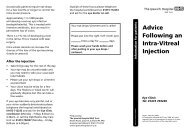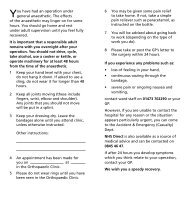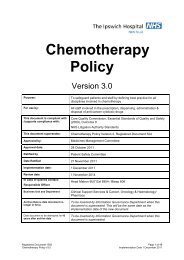Patellofemoral (Kneecap) Realignment - Ipswich Hospital
Patellofemoral (Kneecap) Realignment - Ipswich Hospital
Patellofemoral (Kneecap) Realignment - Ipswich Hospital
You also want an ePaper? Increase the reach of your titles
YUMPU automatically turns print PDFs into web optimized ePapers that Google loves.
What is a patellofemoral realignment?A patellofemoral realignment operation involves some or all of thefollowing:1 A ‘lateral release’ of the tight capsule on the outer side of thepatella.2 The tibial tuberosity may be moved sideways, downwards andforwards as needed (known as a TT transfer). The tuberosity isthen fixed in its new position with a screw.3 A ‘VMO advancement’ is performed to move the inner part of thequadriceps muscle across the patella to improve its mechanicalefficiency. Alternatively, a MPFL reconstruction may be performedto replace the ligament which is commonly torn when the patelladislocates.4 Patella chondroplasty: any rough areas of joint surface are shavedsmooth.Rarely, a trochleaplasty is performed to deepen an abnormally shallowtrochlea groove.Following a patellofemoral realignment operation, the recovery takesseveral months and a specific rehabilitation programme will needto be followed. If a TT transfer has been performed then the screwfixation will need to be protected by limiting knee movement in aknee brace.A diagram illustrating the various stepsinvolved in a patellofemoral realignmentoperation.TT = tibial tuberosity.VMO = inner part of the quadriceps muscle.Page
What are the benefits of having a patellofemoralrealignment?1 A stable knee. The patella tracks more normally and should notdislocate.2 Less pain. A patella that tracks more normally is likely to be lesspainful, although some pain may persist, depending on the extentof any damage that has already happened.A patellofemoral realignment operation is generally a very successfuloperation in preventing further dislocation of the patella: 95% (or 19out of 20 patients) will never dislocate again.Patients with anterior knee pain and maltracking typically have a 75%chance of a good outcome. In other words, three out of four patientshave good relief of their symptoms of anterior knee pain and givingway.Your surgeon will discuss your injury and the treatment options withyou. However it is your decision whether or not to have surgery.What are the risks of having a patellofemoralrealignment?Some of the risks are listed below. Although there seem to be a largenumber of possible risks, the chance of a significant problem is lessthan 10% (one patient in 10).Medical problemsThe risk of developing a major illness, such as a chest infection, isuncommon after a patellofemoral realignment.Blood clots (DVT and PE)Following surgery to the legs blood clots can form in the deep veinsof the calf or thigh (deep vein thrombosis or DVT). This usuallycauses pain and swelling in the calf or thigh. Occasionally part ofthe blood clot can break free and travel in the bloodstream to thelungs (a pulmonary embolism or PE). A PE can be life threatening butfortunately this is extremely rare after a patellofemoral realignment.Page
InfectionA wound infection may occur but usually responds to antibiotics. Amore serious infection within the knee joint is rare (less than one in400).BleedingSome bleeding occurs after any operation. Occasionally a deepcollection of blood (called a haematoma) may persist. This usuallyresponds to ice and physiotherapy.Nerve injuryA patch of numbness around the scars is usual. The numb area tendsto shrink with time.Metalwork irritationUsually the screw used to fix the tibial tuberosity is left inpermanently. However, if it is uncomfortable it can be removed.Kneeling discomfortSome tenderness of the scar can cause persistent discomfort onkneeling.StiffnessOver the first few months after surgery it requires hard work andcommitment to maximise the movement you gain from your newknee. Moving the tibial tuberosity downwards can tighten thequadriceps muscle and mean that it may be difficult to bend the kneefully. Occasionally the knee can remain stiff. This may be due to excessscarring within the knee, which may require a further operation.OsteoarthritisSome patients develop osteoarthritis (arthritis due to ‘wear andtear’) after a patellofemoral realignment. Usually this is the result ofdamage to the joint surfaces sustained before the operation.Page
What does a patellofemoral realignment operationinvolve?Before the operationIt is advisable to continue a non-operative treatment programme(such as straight leg raises, hamstring stretches, weight loss, etc) as thiscan help keep your symptoms under control and also help speed upyour recovery following the operation.Further details about a non-operative treatment programme are inour separate booklet <strong>Patellofemoral</strong> (<strong>Kneecap</strong>) Problems.The operationUsually you will be admitted on the morning of the operation. Theoperation may be performed under general anaesthesia (when youare fully asleep) or occasionally spinal anaesthesia (an injection oflocal anaesthetic into the back leads to numbness of the legs). Youranaesthetist will discuss the exact type of anaesthetic with you whenyou are admitted to hospital.The operation itself lasts about 1-2 hours. Including preparation andrecovery, you will be away from the ward for at least three hours.Recovery in hospitalPhysiotherapy is started as soon as possible after you have recoveredfrom the anaesthetic. If your tibial tuberosity has been moved, youwill be fitted with a brace that restricts how far you can bend yourknee. The brace will protect the tibial tuberosity until it has healedin its new position (this usually takes 6-8 weeks). Usually the range ofmovement allowed by the brace will be gradually increased over theweeks. You may also need crutches to help you walk. Most patientswill be able to go home within 2-3 days.The wound may be closed with surgical clips or stitched with anabsorbable or non-absorbable stitch. The ward nurses will give youadvice about your wound before you go home.Page
After leaving hospitalThe discomfort of the operation settles steadily but you may needto continue with pain relief medication for a few weeks. Initially it isnormal to have some swelling, bruising and weakness of the leg.The end result depends greatly on your rehabilitation after theoperation. You will need to work hard on both regaining the fullmovement of the knee and building up the strength of the muscles.Your physiotherapist will guide you through a specific rehabilitationprogramme. The following is a guideline:• First six weeks. Initially you may need crutches to walk. Applying anice pack for short periods will help reduce any swelling. If you havebeen fitted with a brace this will restrict how far you can bend yourknee. Usually the range of movement allowed by the brace will begradually increased over 6-8 weeks and you should aim to regain asmuch movement as the brace will allow. Quadriceps strengtheningexercises will be started.• 6-12 weeks. You should be reviewed in the outpatient clinic 6-8weeks after the operation. If you have been fitted with a brace,you will be allowed to stop wearing this once your surgeon haschecked on your x-rays that the tibial tuberosity has healed well.You can then work on regaining a full range of motion and walkingnormally. You will also start further strengthening exercises.• 12 weeks – six months. Agility work and low-risk sporting activitycan begin. Later on you may start sport-specific exercises.Return to workOffice workers may be able to return to work after 1-2 weeks. Return toother forms of work should be discussed with your surgeon.Return to drivingYou may return to driving when it is comfortable and safe. If theright knee has been reconstructed, you must be able to walk withoutcrutches and you must be able to stamp hard on the brake pedalwithout flinching so that you can perform a safe emergency stop ifneeded.Page
Return to sportYou should make a gradual return to full training and competitivesport only when your strength, range of motion and coordinationhave recovered fully.Your surgeon may recommend some restrictions to your sportingactivity. For example, if significant damage to the joint surfaces is seenat the time of surgery, you may be advised to minimise any repetitiveweight-bearing involving bending and straightening of the knee (suchas running uphill, stair-climbing, stepping exercises).X-rays (side views) of a knee before and after a successfulpatellofemoral realignment operation.Before the operation (left) the patella is higher than normal.After the operation (right) a fixation screw can be seen. This is fixingthe tibial tuberosity, which has been moved downwards to lower theposition of the patella.Page 10
Further informationIf you have any queries, please contact your consultant’s secretary.If you have any concerns during your recovery after a patellofemoralrealignment operation, please contact your consultant’s secretary orthe ward on which you stayed. They may be contacted via the hospitalswitchboard on 01473 712233.Page 11
Produced by:The <strong>Ipswich</strong> <strong>Hospital</strong> NHS TrustHeath Road, <strong>Ipswich</strong>, Suffolk IP4 5PD<strong>Hospital</strong> switchboard: 01473 712233www.ipswichhospital.nhs.uk
















